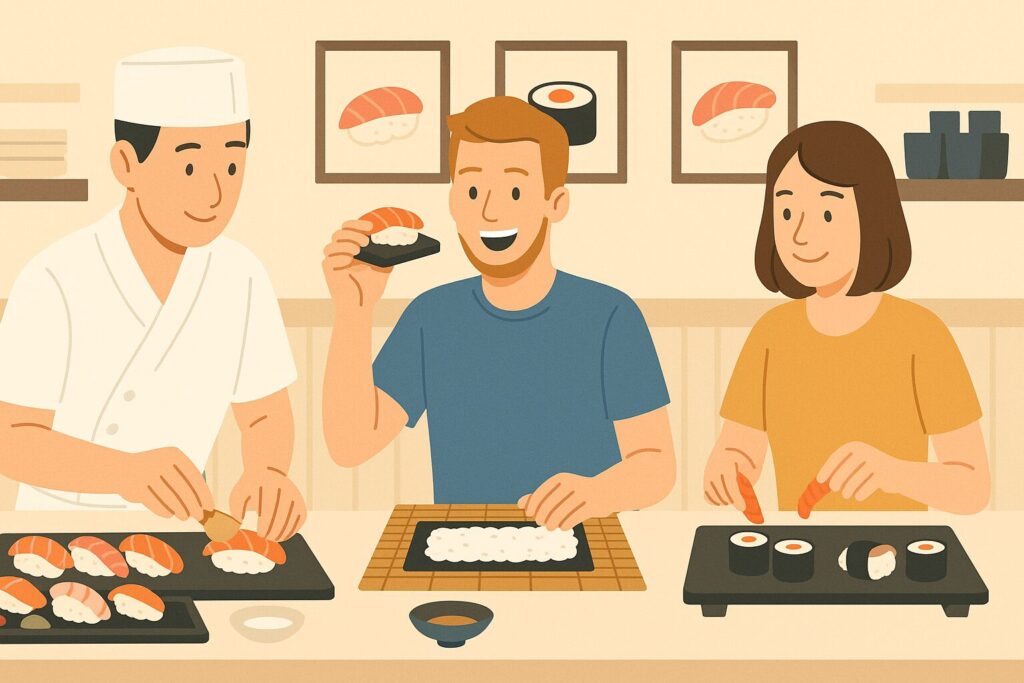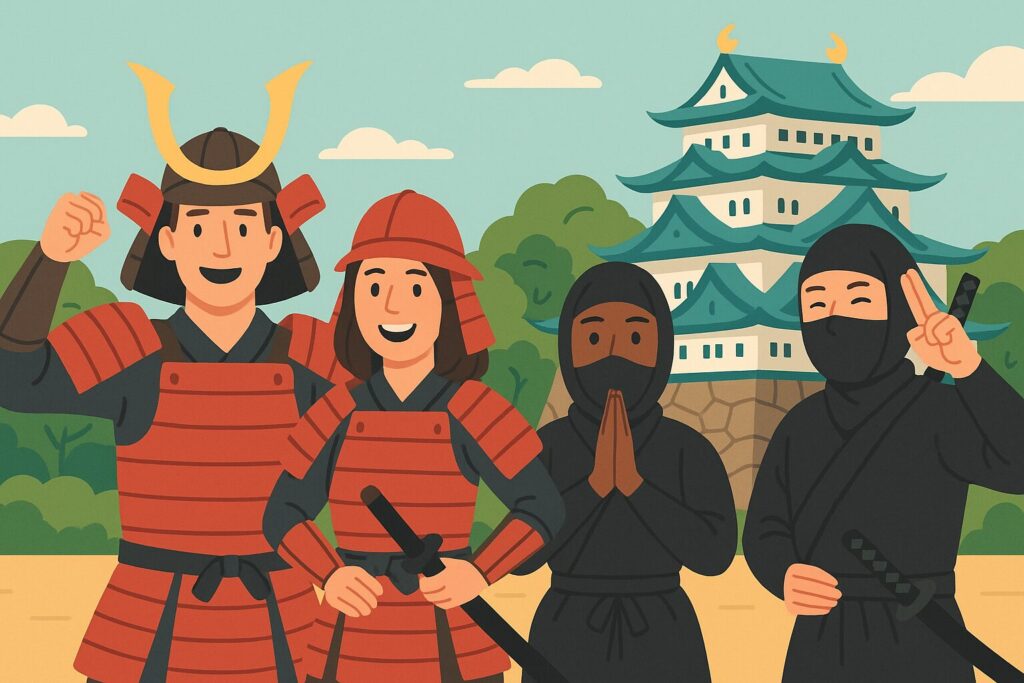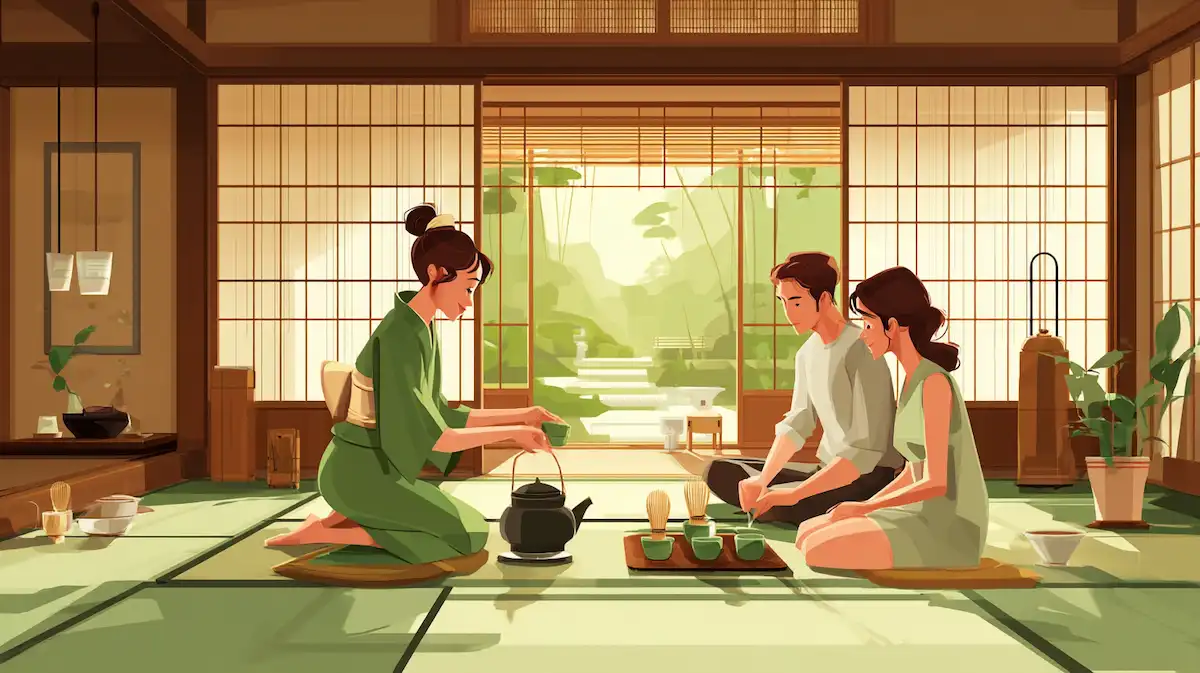日本文化体験を英語で説明・紹介するための基本情報と、英会話に役立つ表現をシンプルでわかりやすい英語で紹介します。
英会話ダイアローグ・概要・10の質問を通して、日本文化体験に関する英語表現を学びます。
英語
英会話ダイアローグを読む前に知っておくと良い前提知識と情報です。
- 日本文化体験とは
- 主な特徴
- 多くの体験は、専門の先生や職人、地元の人が直接指導
- 本物の寺院や和室、工房など、伝統的な場所で行われることが多い
- 季節や行事に合わせた内容もあり、日本独自の“季節感”が大切にされている
- 初心者や外国人観光客向けに英語ガイドやサポートが用意されている体験も増えている
- 人気の理由
- 日本独自の文化や美意識(例:わびさび)を“自分でやってみる”ことで、より深く理解できる
- 先生や地元の人と直接交流できるため、リアルな日本を体感できる
- 体験を通して、他では得られない特別な思い出や写真が残せる
- 観光客だけでなく、日本在住の外国人や日本人にも人気がある
- 参加方法・注意点
- ほとんどの体験は予約制(特に人気のあるものは早めの予約が必要)
- 動きやすい服装や靴、体験内容によっては着替えやエプロンなどを持参すると安心
- 価格帯は数千円からで、内容や場所によって異なる
2人が日本文化体験について話しています。
茶道や着物、書道、寿司作り、侍・忍者体験など、日本文化体験の概要や魅力、人気の理由、参加方法などを話題にしています。
会話 / dialogue

Hey Key, have you ever tried any Japanese cultural experiences?

Yeah, actually, I have. I joined a tea ceremony last spring. Why do you ask?

I’ve been thinking about it lately. I want to learn more about Japanese culture, not just see the famous spots. What exactly are Japanese cultural experiences?

They’re hands-on activities where you can try traditional things yourself—like tea ceremony, kimono wearing, calligraphy, sushi making, and more.

So it’s not just watching, but actually doing things?

Exactly. That’s the best part. You can really use all your senses—taste, touch, see, hear, and even smell the atmosphere.

That sounds much deeper than just sightseeing. What’s so special about these experiences?

Well, first, you often learn directly from real experts—like a tea master, a calligraphy teacher, or even a craftsman. The settings are usually authentic, such as temples, old houses, or proper studios.

Interesting. Is there a strong connection to Japanese traditions and the seasons?

Yes, definitely. Many activities match the seasons—like doing tea ceremony with cherry blossoms in spring or making sweets that fit the time of year. It’s all about enjoying the moment.

I’ve heard the word “wabi-sabi” before. Is that part of it?

For sure. “Wabi-sabi” means finding beauty in simplicity and imperfection. You’ll notice it in things like the tea room’s design, handmade pottery, and even the way people behave during the experiences.

Are these experiences popular with foreign tourists?

Very popular! Many visitors want to do more than just take photos—they want to join in, make something, and talk to locals. Experiences like tea ceremony, kimono wearing, and even samurai or ninja lessons are top choices.

Why do you think foreigners love them so much?

Probably because they’re so different from what people can do in their own countries. Also, you get to meet Japanese people, learn real customs, and take home a unique memory—not just a souvenir.

Do you need any special skills or Japanese language to join?

Not really. Most places welcome beginners, and more and more have English instructions or guides. Just bring your curiosity!

That’s good to know. I’m especially interested in making sushi and trying on kimono. What was your favorite part of the tea ceremony?

I loved the calm atmosphere and the focus on manners. It made me feel connected to Japanese history and values.

Is it expensive to join these activities?

It depends, but many are quite reasonable. Some experiences cost just a few thousand yen. It’s a good value for what you get.

Are there any new or modern types of cultural experiences?

Yes! Now there are things like virtual temple tours, AR stamp collecting at shrines, and even anime drawing classes with digital tools. It’s a mix of tradition and technology.

That sounds so cool. Do you think I’d enjoy the samurai or ninja experiences too?

Absolutely. You get to wear the costumes, learn some moves, and even take fun photos. It’s really popular for people of all ages.

What would you recommend for someone’s first time?

Maybe start with tea ceremony or sushi making—they’re classic and not too difficult. But honestly, any experience will give you a deeper feeling for Japanese culture.

I want to try as many as I can. Do you have to book in advance?

Yes, it’s better to book ahead, especially for popular activities in busy seasons.

Thanks for all the info, Key. I feel much more excited to try these now.

No problem! Let me know if you want company. Japanese cultural experiences are always better when you can share them.

I will! Maybe we can do sushi making together next weekend.

Sounds great. I’ll look up some good places and send you the details.
概要 / Overview
「日本文化体験」について、理解を深めるための「英語での概要」です。
日本文化体験

What Are Japanese Cultural Experiences?
Japanese cultural experiences are special activities where you can try Japanese traditions for yourself. These experiences include tea ceremony, wearing kimono, making Japanese sweets, calligraphy, sushi making, and even samurai or ninja lessons. Instead of just watching, you do things with your own hands. Many classes happen in real temples, old houses, or studios, so you can feel the real Japanese atmosphere.
Main Features
One main point is that you learn from real experts, such as tea masters or calligraphy teachers. They show you traditional skills and manners. You use all your senses—you can see, taste, touch, hear, and even smell different things. Many experiences also change with the seasons. For example, you might enjoy tea with cherry blossoms in spring or make sweets for a special festival.
Why Are They Popular?
These experiences are very popular with foreign tourists and Japanese people, too. People like them because they are different from things in their own countries. You can make new friends, learn Japanese customs, and take home a special memory. Most activities are easy to join, even for beginners, and many places have English guides or instructions.
Conclusion
Japanese cultural experiences are a great way to understand Japan more deeply. You do not just see Japanese culture—you can feel it. These activities help make your trip to Japan fun and unforgettable.
10の質問 / 10 questions
「日本文化体験」について、理解を深めるための「英語での10の質問」です。
1: What are Japanese cultural experiences?
Japanese cultural experiences are activities where you can try traditional Japanese things, like tea ceremony, kimono wearing, or calligraphy, by yourself.
2: Why do people like Japanese cultural experiences?
People like them because they can learn about real Japanese life and culture, not just see tourist spots.
3: What is the tea ceremony?
The tea ceremony is a special way of making and drinking Japanese green tea, called matcha. You also learn about manners and enjoy Japanese sweets.
4: Can anyone join a Japanese cultural experience?
Yes, most experiences are open to everyone, even beginners. Many places have English instructions, so it is easy to join.
5: Where do these experiences happen?
Many activities take place in real temples, old houses, or studios. The setting is usually very traditional.
6: What can you learn from doing calligraphy?
You can learn how to use a brush and ink to write Japanese characters. You also learn to focus and relax while writing.
7: Are Japanese cultural experiences expensive?
Some activities are cheap and some cost more, but many are reasonable. Prices usually start from a few thousand yen.
8: Are these experiences popular with tourists?
Yes, they are very popular with tourists from around the world. Many people want to make special memories during their trip to Japan.
9: Do you need to book in advance?
It is better to book in advance, especially for popular experiences or busy seasons.
10: What are some new types of Japanese cultural experiences?
Some new experiences include virtual temple tours, AR stamp collecting, and anime drawing classes using digital tools.

和訳付
会話 / dialogue

Hey Key, have you ever tried any Japanese cultural experiences?
ねえキー、日本文化体験ってやったことある?

Yeah, actually, I have. I joined a tea ceremony last spring. Why do you ask?
うん、あるよ。去年の春に茶道体験に参加したんだ。どうして聞くの?

I’ve been thinking about it lately. I want to learn more about Japanese culture, not just see the famous spots. What exactly are Japanese cultural experiences?
最近ちょっと気になっててさ。有名な観光地を見るだけじゃなくて、日本文化をもっと深く知りたいんだ。日本文化体験って具体的にどんなものなの?

They’re hands-on activities where you can try traditional things yourself—like tea ceremony, kimono wearing, calligraphy, sushi making, and more.
自分で伝統的なことに挑戦できる体験のことだよ。たとえば茶道、着物の着付け、書道、寿司作りとか、いろいろあるんだ。

So it’s not just watching, but actually doing things?
見るだけじゃなくて、自分でやってみる感じなんだ?

Exactly. That’s the best part. You can really use all your senses—taste, touch, see, hear, and even smell the atmosphere.
そう、それが一番の魅力なんだよ。味わったり、触ったり、見たり、聞いたり、雰囲気を香りで感じたり、五感を全部使えるんだ。

That sounds much deeper than just sightseeing. What’s so special about these experiences?
ただ観光するよりずっと深い体験だね。そういう体験の何が特別なの?

Well, first, you often learn directly from real experts—like a tea master, a calligraphy teacher, or even a craftsman. The settings are usually authentic, such as temples, old houses, or proper studios.
まず本物の先生から直接学べることかな。茶道ならお茶の先生、書道なら先生や職人さんが教えてくれるんだ。場所も本当の寺院や古民家、専門の工房でやることが多いよ。

Interesting. Is there a strong connection to Japanese traditions and the seasons?
なるほど。日本の伝統とか季節感と結びついてることも多いの?

Yes, definitely. Many activities match the seasons—like doing tea ceremony with cherry blossoms in spring or making sweets that fit the time of year. It’s all about enjoying the moment.
うん、すごくあるよ。春の桜を見ながら茶道をやったり、その季節に合った和菓子を作ったり、季節感を大事にしてるんだ。今を楽しむっていう考え方なんだよ。

I’ve heard the word “wabi-sabi” before. Is that part of it?
「わびさび」って言葉を聞いたことあるんだけど、それも関係あるの?

For sure. “Wabi-sabi” means finding beauty in simplicity and imperfection. You’ll notice it in things like the tea room’s design, handmade pottery, and even the way people behave during the experiences.
もちろん関係あるよ。「わびさび」は、シンプルさや不完全さの中に美しさを見つける考え方。茶室のつくりや手作りの器、体験中の所作にもそれが表れてるよ。

Are these experiences popular with foreign tourists?
こういう体験って外国人観光客にも人気なの?

Very popular! Many visitors want to do more than just take photos—they want to join in, make something, and talk to locals. Experiences like tea ceremony, kimono wearing, and even samurai or ninja lessons are top choices.
めちゃくちゃ人気だよ!写真を撮るだけじゃなくて、自分で参加して何か作ったり、地元の人と話したりしたい人が多いんだ。茶道や着物、侍や忍者体験も大人気だよ。

Why do you think foreigners love them so much?
なんでそんなに外国の人たちにウケてるんだろう?

Probably because they’re so different from what people can do in their own countries. Also, you get to meet Japanese people, learn real customs, and take home a unique memory—not just a souvenir.
たぶん、自分の国じゃできない体験だからかな。それに日本の人と直接話したり、本当の習慣を学べたり、単なるお土産じゃなくて特別な思い出が持ち帰れるからだと思う。

Do you need any special skills or Japanese language to join?
参加するのに特別なスキルとか日本語力って必要?

Not really. Most places welcome beginners, and more and more have English instructions or guides. Just bring your curiosity!
全然いらないよ。ほとんどのところは初心者歓迎だし、最近は英語の説明やガイドも増えてきてるし。興味さえあれば十分!

That’s good to know. I’m especially interested in making sushi and trying on kimono. What was your favorite part of the tea ceremony?
それは安心だね。僕は寿司作りと着物体験に特に興味あるな。キーは茶道で一番良かったことって何?

I loved the calm atmosphere and the focus on manners. It made me feel connected to Japanese history and values.
静かな雰囲気と礼儀作法を大切にするところが良かったよ。日本の歴史や価値観とつながっている感じがしたんだ。

Is it expensive to join these activities?
こういう体験って高いのかな?

It depends, but many are quite reasonable. Some experiences cost just a few thousand yen. It’s a good value for what you get.
体験によるけど、意外とリーズナブルなものが多いよ。数千円でできるものも結構あるし、内容を考えたらすごくお得だと思う。

Are there any new or modern types of cultural experiences?
新しいタイプとか現代風の文化体験もあるの?

Yes! Now there are things like virtual temple tours, AR stamp collecting at shrines, and even anime drawing classes with digital tools. It’s a mix of tradition and technology.
あるよ!今はバーチャルお寺ツアーとか、神社でARスタンプラリー、デジタルでアニメ作画体験なんかもできるんだ。伝統とテクノロジーの融合って感じだよ。

That sounds so cool. Do you think I’d enjoy the samurai or ninja experiences too?
それ面白そう!僕も侍や忍者体験、楽しめそうかな?

Absolutely. You get to wear the costumes, learn some moves, and even take fun photos. It’s really popular for people of all ages.
絶対楽しいと思うよ!衣装を着てポーズを決めたり、簡単な動きも教えてくれるし、写真もたくさん撮れるし。年齢問わず人気だよ。

What would you recommend for someone’s first time?
初めての人には何がおすすめ?

Maybe start with tea ceremony or sushi making—they’re classic and not too difficult. But honestly, any experience will give you a deeper feeling for Japanese culture.
茶道か寿司作りが定番でやりやすいかな。でも正直、どれでも日本文化を深く感じられると思うよ。

I want to try as many as I can. Do you have to book in advance?
できるだけ色々やってみたいな。事前予約って必要?

Yes, it’s better to book ahead, especially for popular activities in busy seasons.
うん、特に人気の体験や混む時期は、早めに予約した方がいいよ。

Thanks for all the info, Key. I feel much more excited to try these now.
色々教えてくれてありがとう、キー。ますますやってみたくなったよ!

No problem! Let me know if you want company. Japanese cultural experiences are always better when you can share them.
いいよ!一緒に行きたいときは声かけて。日本文化体験は誰かと共有した方が絶対楽しいよ。

I will! Maybe we can do sushi making together next weekend.
そうする!今度の週末、寿司作り体験に一緒に行くのはどう?

Sounds great. I’ll look up some good places and send you the details.
いいね!おすすめの場所探して、また連絡するね。
概要 / Overview
日本文化体験

What Are Japanese Cultural Experiences?
Japanese cultural experiences are special activities where you can try Japanese traditions for yourself. These experiences include tea ceremony, wearing kimono, making Japanese sweets, calligraphy, sushi making, and even samurai or ninja lessons. Instead of just watching, you do things with your own hands. Many classes happen in real temples, old houses, or studios, so you can feel the real Japanese atmosphere.
日本文化体験とは?
日本文化体験とは、自分で日本の伝統を体験できる特別なアクティビティです。茶道、着物の着付け、和菓子作り、書道、寿司作り、侍や忍者体験などがあります。ただ見学するだけでなく、自分の手で実際にやってみることがポイントです。多くの体験は本物のお寺や古民家、工房などで行われ、日本の本当の雰囲気を味わえます。
Main Features
One main point is that you learn from real experts, such as tea masters or calligraphy teachers. They show you traditional skills and manners. You use all your senses—you can see, taste, touch, hear, and even smell different things. Many experiences also change with the seasons. For example, you might enjoy tea with cherry blossoms in spring or make sweets for a special festival.
主な特徴
一番の特徴は、茶道の先生や書道の先生など本物の専門家から学べることです。先生たちは伝統的な技術や礼儀作法を教えてくれます。五感を使い、見たり、味わったり、触ったり、聞いたり、香りを楽しんだりできます。体験は季節によって内容が変わることも多く、例えば春には桜を見ながらお茶を楽しんだり、お祭りに合わせた和菓子を作ったりします。
Why Are They Popular?
These experiences are very popular with foreign tourists and Japanese people, too. People like them because they are different from things in their own countries. You can make new friends, learn Japanese customs, and take home a special memory. Most activities are easy to join, even for beginners, and many places have English guides or instructions.
なぜ人気なのか
こうした体験は外国人観光客にも日本人にもとても人気です。自分の国ではできないことが多く、新鮮に感じられるからです。新しい友達ができたり、日本独自の習慣を学んだり、特別な思い出を持ち帰ることができます。ほとんどの体験は初心者でも簡単に参加でき、英語での案内や説明も増えています。
Conclusion
Japanese cultural experiences are a great way to understand Japan more deeply. You do not just see Japanese culture—you can feel it. These activities help make your trip to Japan fun and unforgettable.
まとめ
日本文化体験は、日本をもっと深く知るのにとても良い方法です。ただ日本文化を「見る」のではなく、「感じる」ことができます。こうした体験は、日本への旅を楽しく、忘れられないものにしてくれます。
10の質問 / 10 questions
1: What are Japanese cultural experiences?
日本文化体験とは何ですか?
Japanese cultural experiences are activities where you can try traditional Japanese things, like tea ceremony, kimono wearing, or calligraphy, by yourself.
日本文化体験とは、茶道や着物の着付け、書道など日本の伝統的なことを自分で体験できる活動のことです。
2: Why do people like Japanese cultural experiences?
なぜ人々は日本文化体験が好きなのですか?
People like them because they can learn about real Japanese life and culture, not just see tourist spots.
観光地を見るだけでなく、本当の日本の生活や文化を学べるので人気があります。
3: What is the tea ceremony?
茶道とは何ですか?
The tea ceremony is a special way of making and drinking Japanese green tea, called matcha. You also learn about manners and enjoy Japanese sweets.
茶道とは、抹茶という日本の緑茶を特別な方法で点てて飲む体験です。礼儀作法や和菓子も楽しめます。
4: Can anyone join a Japanese cultural experience?
誰でも日本文化体験に参加できますか?
Yes, most experiences are open to everyone, even beginners. Many places have English instructions, so it is easy to join.
はい、ほとんどの体験は初心者でも誰でも参加できます。英語の説明がある場所も多いので安心です。
5: Where do these experiences happen?
これらの体験はどこで行われますか?
Many activities take place in real temples, old houses, or studios. The setting is usually very traditional.
多くの体験は本物のお寺や古民家、工房など、伝統的な場所で行われます。
6: What can you learn from doing calligraphy?
書道体験では何が学べますか?
You can learn how to use a brush and ink to write Japanese characters. You also learn to focus and relax while writing.
筆と墨で日本の文字を書く方法を学べます。また、集中したりリラックスしたりすることも学べます。
7: Are Japanese cultural experiences expensive?
日本文化体験は高いですか?
Some activities are cheap and some cost more, but many are reasonable. Prices usually start from a few thousand yen.
安いものもあれば高いものもありますが、多くは手ごろです。料金はだいたい数千円からです。
8: Are these experiences popular with tourists?
これらの体験は観光客に人気ですか?
Yes, they are very popular with tourists from around the world. Many people want to make special memories during their trip to Japan.
はい、世界中の観光客にとても人気があります。多くの人が日本旅行で特別な思い出を作りたいと思っています。
9: Do you need to book in advance?
事前に予約する必要がありますか?
It is better to book in advance, especially for popular experiences or busy seasons.
特に人気のある体験や混雑する時期は、事前予約をするのがおすすめです。
10: What are some new types of Japanese cultural experiences?
新しいタイプの日本文化体験にはどんなものがありますか?
Some new experiences include virtual temple tours, AR stamp collecting, and anime drawing classes using digital tools.
バーチャル寺院ツアーやARスタンプラリー、デジタルツールを使ったアニメ作画体験など、新しい体験もあります。

words & phrases
英会話ダイアローグと関連情報に出てきた単語・フレーズです(例文は各3つ)。

hands-on : 形容詞
意味: 実際に手を使って体験する、実践的な。Directly involving practical experience rather than just theory.
(日本文化体験で「見るだけ」でなく「自分でやってみる」ことを強調する際に使用)
例文:
- The class gave students a hands-on experience in making sushi.
「その授業では、学生が実際に寿司を作る体験ができました。」 - This workshop is very hands-on and fun for beginners.
「このワークショップはとても実践的で、初心者にも楽しいです。」 - Many people enjoy hands-on activities when traveling.
「多くの人は旅行中に体験型アクティビティを楽しみます。」
authentic : 形容詞
意味: 本物の、伝統的な、信頼できる。Real or genuine; true to tradition or original style.
(日本文化体験で本物の場所や職人・先生による体験であることを示す際に使用)
例文:
- The tea ceremony was held in an authentic Japanese tea room.
「茶道体験は本物の日本の茶室で行われました。」 - Visitors love authentic cultural experiences in Japan.
「訪問者は日本で本物の文化体験を好みます。」 - She learned to cook authentic Japanese dishes.
「彼女は本格的な日本料理の作り方を学びました。」
imperfection : 名詞
意味: 不完全、欠点、完全ではないこと。The state of being not perfect; a small fault or flaw.
(「わびさび」の精神、日本文化体験で“シンプルさや不完全さの美しさ”を表現する時に使用)
例文:
- There is beauty in imperfection in Japanese art.
「日本の芸術には不完全さの中に美があります。」 - They accept small imperfections in handmade pottery.
「手作りの陶器のちょっとした欠点も受け入れます。」 - Imperfection is a key part of wabi-sabi.
「不完全さはわびさびの重要な要素です。」
calligraphy : 名詞
意味: 書道、美しい書き方、筆記の芸術。The art of beautiful handwriting, often using a brush or special pen.
(日本文化体験の一つとして筆や墨を使って日本語を書く体験を指す)
例文:
- I took a calligraphy class during my trip to Japan.
「日本旅行中に書道教室に参加しました。」 - Japanese calligraphy uses a brush and black ink.
「日本の書道は筆と墨を使います。」 - Learning calligraphy helps you focus and relax.
「書道を学ぶことで集中したりリラックスしたりできます。」
